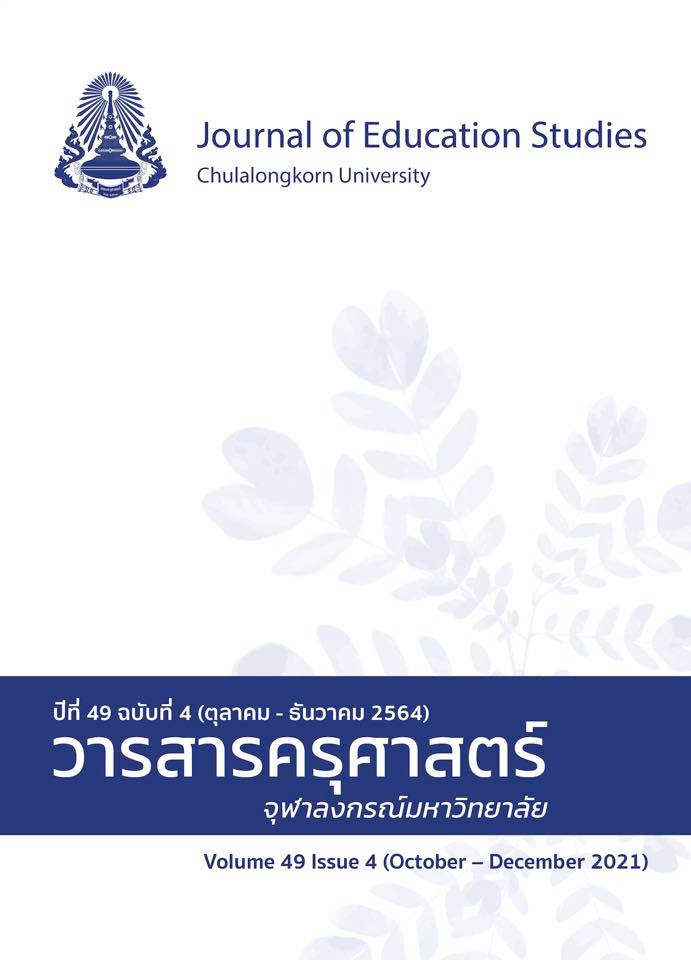Guidelines for Designing Mathematical Problems and Real-life Problems with the Development of Critical Thinking
DOI:
https://doi.org/10.14456/educu.2021.73Keywords:
critical thinking, mathematical problems, real-life problemsAbstract
The concepts of critical thinking in this article are reflective thinking, reasoning, analyzing, and evaluating information in order to decide what to do about situations or to solve problems. There were several guidelines to develop students’ critical thinking skills in the mathematics classroom. In this article, four appropriate guidelines for situations or problems designing to develop critical thinking in mathematics classroom were proposed which were 1) mathematical problems that had many correct answers or different solving methods, 2) realistic mathematical word problems that students could use experiences to solve, 3) ill-structured mathematical problems, and 4) real-life situations or problems which students could use their mathematical knowledge, ideas, and experiences to describe or solve. The purpose of these designed situations and problems was to develop some specific abilities of critical thinking. In addition, mathematical knowledge for describing or solving the designed situations or problems should not be at an extremely high level which might interrupt the development of critical thinking skills.
References
วรนิพิฎ พันธ์หนองหว้า. (2559). ผลของการจัดกิจกรรมการเรียนรู้คณิตศาสตร์โดยใช้กระบวนการแก้ปัญหาที่มีโครงสร้างไม่
สมบูรณ์ร่วมกับกลวิธีการเสริมต่อความคิดที่มีต่อความสามารถในการคิดอย่างมีวิจารณญาณของนักเรียนชั้น
มัธยมศึกษาปีที่ 3 [วิทยานิพนธ์ปริญญามหาบัณฑิต, จุฬาลงกรณ์มหาวิทยาลัย]. Chulalongkorn University Intellectual Repository (CUIR). http://cuir.car.chula.ac.th/handle/123456789/55144
สำนักงานคณะกรรมการการศึกษาขั้นพื้นฐาน กระทรวงศึกษาธิการ. (2560). ตัวชี้วัดและสาระการเรียนรู้แกนกลาง กลุ่มสาระ
การเรียนรู้คณิตศาสตร์ (ฉบับปรับปรุง พ.ศ. 2560) ตามหลักสูตรแกนกลางการศึกษาขั้นพื้นฐาน พุทธศักราช 2551.
โรงพิมพ์ชุมนุมสหกรณ์การเกษตรแห่งประเทศไทย.
สุวรรณี เปลี่ยนรัมย์ และ ไมตรี อินทร์ประสิทธิ์. (2550). การศึกษาการคิดอย่างมีวิจารณญาณในสถานการณ์การแก้ปัญหา
แบบปลายเปิดทางคณิตศาสตร์. วารสารวิจัย มข. (ฉบับบัณฑิตศึกษา), 7(2), 208–217. https://ph02.tci-
thaijo.org/index.php/gskku/article/view/23852
เสาวลักษณ์ สุวรรณชัยรบ. (2563). ผลการจัดกิจกรรมการเรียนรู้คณิตศาสตร์โดยใช้การเรียนรู้แบบสืบสอบที่มีต่อความรู้ทาง
คณิตศาสตร์ และการคิดอย่างมีวิจารณญาณของนักเรียนมัธยมศึกษาปีที่ 3 [วิทยานิพนธ์ปริญญามหาบัณฑิต,
จุฬาลงกรณ์มหาวิทยาลัย]. Chulalongkorn University Intellectual Repository (CUIR). http://cuir.car.
chula.ac.th/handle/123456789/76677
ภาษาอังกฤษ
Afifah, S. A., & Agoestanto, A. (2020). Mathematical critical thinking ability in solving open-ended questions
viewed from students’ curiosity. Unnes Journal of Mathematics Education, 9(1), 36-42.
https://doi.org/10.15294/ujme.v9i1.38099
Dwyer, C. P., Hogan, M. J., & Stewart, I. (2014). An integrated critical thinking framework for the 21st
century. Thinking skills and Creativity, 12, 43-52. https://doi.org/10.1016/j.tsc.2013.12.004
Ennis, R. H. (1985). A logical basis for measuring critical thinking skills. Educational Leadership, 43(2), 44 - 48.
Hikayat, C., Suparman, Hairun, Y., & Suharna, H. (2020). Design of realistic mathematics education approach
to improve critical thinking skills. Universal Journal of Educational Research, 8(6), 2232 - 2244.
https://doi.org/10.13189/ujer.2020.080606
Kennedy, M., Fisher, M. B., & Ennis, R. H. (1991). Critical thinking: Literature review and needed research.
In L. Idol & B. F. Jones (Eds.), Educational Values and Cognitive Instruction: Implications for Reform
(pp. 11 – 40). Lawrence Erlbaum.
Lai, E. R. (2011). Critical thinking: A literature review. Pearson Education.
Leader, L. F., & Middleton, J. A. (2004). Promoting critical-thinking dispositions by using problem solving in
middle school mathematics. Research in Middle School Level Education Online, 28(1), 1 -13.
https://doi.org/10.1080/19404476.2004.11658174
Partnership for 21st Century Skills. (2011). P21 common core toolkit: A guide to aligning the common core
state standards with the framework for 21st century skills. ERIC Clearinghouse.
Peter, E. E. (2012). Critical thinking: Essence for teaching mathematics and mathematics problem solving
skills. African Journal of Mathematics and Computer Science Research, 5(3), 39-43. https://doi.org/
10.5897/AJMCSR11.161
Siriwat, R., & Katwibun, D. (2017). Exploring critical thinking in a mathematics problem-based learning
classroom. In A. Downton, S. Livy, & J. Hall (Eds.), Proceedings of the 40th Annual Conference of
the Mathematics Education Research Group of Australia (pp. 474 - 481). MERGA.
Downloads
Published
How to Cite
Issue
Section
License

This work is licensed under a Creative Commons Attribution-NonCommercial-NoDerivatives 4.0 International License.




